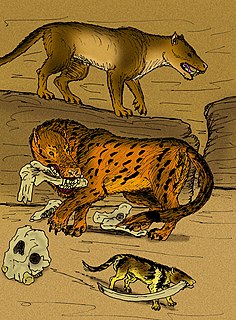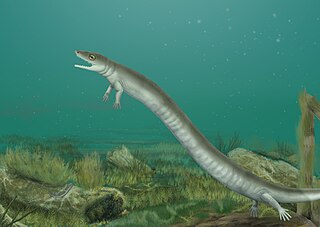 W
WAntecosuchus is an extinct genus of bauriid therocephalians.
 W
WDolichuranus is an extinct genus of dicynodont therapsids from the Middle Triassic Omingonde Formation of Namibia and the Ntawere Formation of Zambia.
 W
WEchmatocrinus is a Cambrian animal which resembles a crinoid or an octocoral. Its exact taxonomy is still a subject of debate. It is known only from the Burgess shale. 5 specimens of Echmatocrinus are known from the Greater Phyllopod bed, where they comprise < 0.1% of the community.
 W
WEfraasia is a genus of basal sauropodomorph dinosaur. It was a herbivore which lived during the middle Norian stage of the Late Triassic, around 210 million years ago, in what is now Germany. It was named in 1973 after Eberhard Fraas, who during the early twentieth century collected what were the original type specimens.
 W
WEnaliarctos is an extinct genus of pinniped, and may represent the ancestor to all pinnipeds. Prior to the discovery of Puijila, the five species in the genus Enaliarctos represented the oldest known pinniped fossils, having been recovered from late Oligocene and early Miocene strata of California and Oregon.
 W
WEudimorphodon was a pterosaur that was discovered in 1973 by Mario Pandolfi in the town of Cene, Italy and described the same year by Rocco Zambelli. The nearly complete skeleton was retrieved from shale deposited during the Late Triassic, making Eudimorphodon one of the oldest pterosaurs known. It had a wingspan of about 100 centimetres (3.3 ft) and at the end of its long bony tail may have been a diamond-shaped flap like in the later Rhamphorhynchus. If so, the flap may have helped it steer while maneuvering in the air. Eudimorphodon is known from several skeletons, including juvenile specimens.
 W
WEutriconodonta is an order of early mammals. Eutriconodonts existed in Asia, Africa, Europe, North and South America during the Jurassic and the Cretaceous periods. The order was named by Kermack et al. in 1973 as a replacement name for the paraphyletic Triconodonta.
 W
WGarganoaetus is an extinct genus of buteonin accipitrid bird of prey from the early Pliocene in Italy. G. freudenthali was comparable in size to a golden eagle; G. murivorus was hawk sized. Species of Garganoaetus would have lived alongside other Gargano island animals, such as large dormice Stertomys and Hattomys hamsters, the giant, long-skulled Deinogalerix moonrats, an otter, Prolagus pikas, and the multi-horned artiodactyl Hoplitomeryx.
 W
WKelmayisaurus is an extinct genus of carcharodontosaurid theropod dinosaur from the early Cretaceous. It was roughly 9–11 meters and its name refers to the petroleum-producing city of Karamay in the Xinjiang province of western China near where it was found.
 W
WMegistotherium is an extinct genus of hyaenodontid, the only known species of which is Megistotherium osteothlastes. It is possibly a junior synonym of Hyainailouros sulzeri.
 W
WMicraroter is an extinct genus of microsaur within the family Ostodolepidae.
 W
WMorganucodonta is an extinct order of basal Mammaliaformes, a group including crown-group mammals (Mammalia) and their close relatives. Their remains have been found in southern Africa, Western Europe, North America, India and China. The morganucodontans were probably insectivorous and nocturnal, though like eutriconodonts some species attained large sizes and were carnivorous. Nocturnality is believed to have evolved in the earliest mammals in the Triassic as a specialisation that allowed them to exploit a safer, night-time niche, while most larger predators were likely to have been active during the day.
 W
WNeopetalichthys yenmenpaensis is an extinct petalichthid placoderm from the Early Devonian of China.
 W
WNoripterus is a genus of dsungaripterid pterodactyloid pterosaur from Lower Cretaceous-age Lianmuqin Formation in the Junggar Basin of Xinjiang, China. It was first named by Yang Zhongjian in 1973. Additional fossil remains have been recovered from Tsagaantsav Svita, Mongolia.
 W
WPhyllodon was a genus of small ornithischian dinosaur from the Kimmeridgian-age Upper Jurassic Camadas de Guimarota Formation of Leiria, Portugal and possibly also the Chipping Norton Limestone of England. It may have been closely related to contemporaneous dinosaurs in North America.
 W
WPraekogia is an extinct genus of cetacean in the family Kogiidae that lived during the Miocene, containing one species: P. cedrosensis. Fossils have been found in Mexico.
 W
WQuasipetalichthys haikouensis is a species of extinct petalichthid placoderm from the Middle Devonian of China.
 W
WShantungosaurus, meaning "Shandong Lizard", is a genus of saurolophine hadrosaurid dinosaurs found in the Late Cretaceous Wangshi Group of the Shandong Peninsula in China, containing a single species, Shantungosaurus giganteus. The stratigraphic interval of Shantungosaurus ranges from the top of the Xingezhuang Formation to the middle of the Hongtuya Formation, middle to late Campanian in age. Shantungosaurus is so far the largest hadrosauroid taxon in the world: the greatest length of its femur is about 1.7 metres (5.6 ft), and the greatest length of its humerus is about 0.97 metres (3.2 ft).
 W
WTurfanosuchus is a genus of archosauriform reptile, likely a gracilisuchid, which lived during the Middle Triassic (Anisian) of northwestern China. The type species, T. dabanensis, was described by C.C. Young in 1973, based on a partially complete but disarticulated fossil skeleton found in the Kelamayi Formation of the Turfan Basin.
 W
WTyto gigantea is an extinct barn owl from what is now Gargano, Italy, dating back to the late Miocene. From its remains, T. gigantea is suggested to have been as large as or larger than the Eurasian eagle-owl.
 W
WWuerhosaurus is a genus of stegosaurid dinosaur from the Early Cretaceous Period of China and Mongolia. As such, it was one of the last genera of stegosaurians known to have existed, since most others lived in the late Jurassic.